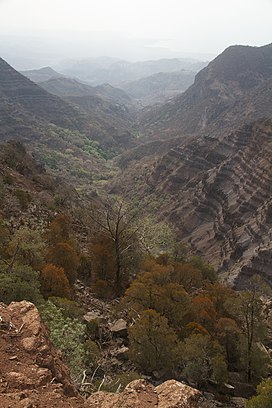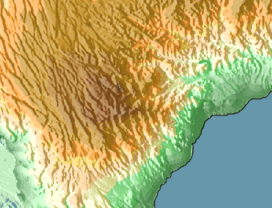268:, with only 4% attributing this to cattle grazing. With the initiative of the local organization Djibouti Nature, residents have built stone walls and fences out of dead wood to help protect areas of the forest from cattle. This initiative has had a visible, positive impact on the condition of the forest. According to the same survey, nearly a quarter of the residents believe that nothing can be done about the damage to the forest, 15% are unsure, 23% believe the wooden fences would further the preservation of the forest, 8% suggest the planting of trees, and 29% believe in a combination of both
300:, with hot and dry summers and cold winters. This is attributed to the fact that Goda Mountains is located on a plain surrounded by mountains and to its distance to the sea and its effects. In the presence of fog, condensation is sometimes considerable. Ground moisture allows plants and trees to survive despite irregular rainfall. Elevation is the major factor affecting temperature levels, with the higher elevated areas being on average 11°C (20°F) cooler than the lower areas. Overnight temperatures can drop as low as 50–54 °F (10–12.2 °C), especially during the December to March winter months.
40:
264:. Once a nomadic population, they now mostly lead sedentary lifestyles. Their pastoral livelihoods are highly dependent on the regularity of rainfall. In 2003, wells with pumps were introduced to the village to ensure a consistent, though limited water supply. The cutting of live trees for firewood is traditionally prohibited; thus only dead wood may be used. Drought is largely held responsible for the
155:
256:
have not been sighted since the 1980s. Climate change is one of the main factors contributing to this loss of species. The Goda
Mountains continue to see longer periods of heat and drought in the region, compounded by grazing (especially of seedlings) and trampling by cattle. Hunting and the cutting
141:
244:, which was once the dominant tree species of the forest. The population of juniper trees in the area has sharply declined, with approximately 50% of the trees dying even in the healthiest regions. Instead,
272:
and fencing. The establishment of a tree nursery in the village Day is just one of the efforts the organization has made to help combat the further depletion of the forest.
217:
611:
72:
289:
39:
662:
65:
667:
213:
216:, Djibouti's only national park. The ecology of this landform is considered an isolated outlier of the
241:
197:
167:
265:
603:
607:
237:
297:
185:
172:
285:
233:
189:
260:
The inhabitants of the nine surrounding villages consists of five different clans of the
248:
has become more common. Subsequently, the antelope population is seeing a rapid decline,
249:
200:
and are the nation's largest heavily vegetated area and is the second highest point in
656:
596:
497:
269:
205:
261:
221:
634:
87:
74:
140:
635:"Climate: Goda Mountains - Climate graph, Temperature graph, Climate table"
17:
201:
193:
160:
281:
253:
55:
245:
209:
240:. It is also one of the few remaining habitats of the
220:
ecoregion, an important island of forest in a sea of
166:
148:
132:
124:
116:
108:
103:
64:
54:
49:
32:
595:
212:. A part of the mountains is protected within the
208:means "twisted" or "devoured" and refers to a
44:Day Forest National Park in the Goda Mountains
8:
196:. They rise to 1,750 metres (5,740 ft)
303:
218:Ethiopian montane grasslands and woodlands
29:
586:
257:of trees also play a subordinate role.
236:are the last remaining refuge for the
60:1,783 m (5,850 ft)at Abeyda
7:
232:The Goda Mountains and the nearby
25:
128:901 km (348 sq mi)
307:Climate data for Goda Mountains
153:
139:
38:
252:have all but disappeared, and
1:
594:Ham, Anthony (30 July 2010).
290:Köppen climate classification
286:subtropical highland climate
426:Mean daily minimum °C (°F)
356:Mean daily maximum °C (°F)
684:
602:. Lonely Planet. pp.
569:
306:
27:Mountain range in Djibouti
495:
425:
355:
350:
347:
344:
341:
338:
335:
332:
329:
326:
323:
320:
317:
314:
311:
296:), with the influence of
137:
37:
214:Day Forest National Park
284:of Goda Mountains is a
120:31 km (19 mi)
112:24 km (15 mi)
663:Mountains of Djibouti
184:lie northwest of the
598:Lonely Planet Africa
242:East African juniper
204:. The name Goda in
84: /
637:. Climate-Data.org
266:forest degradation
50:Highest point
613:978-1-74104-988-6
577:
576:
238:Djibouti spurfowl
178:
177:
16:(Redirected from
675:
668:Tadjourah Region
647:
646:
644:
642:
631:
625:
624:
622:
620:
601:
591:
572:Climate-Data.org
304:
298:mountain climate
186:Gulf of Tadjoura
173:Tadjourah Region
159:
157:
156:
143:
99:
98:
96:
95:
94:
89:
85:
82:
81:
80:
77:
42:
30:
21:
683:
682:
678:
677:
676:
674:
673:
672:
653:
652:
651:
650:
640:
638:
633:
632:
628:
618:
616:
614:
593:
592:
588:
583:
578:
564:
559:
554:
549:
544:
539:
534:
529:
524:
519:
514:
509:
504:
490:
485:
480:
475:
470:
465:
460:
455:
450:
445:
440:
435:
430:
420:
415:
410:
405:
400:
395:
390:
385:
380:
375:
370:
365:
360:
278:
250:desert warthogs
234:Mabla Mountains
230:
198:above sea level
190:Tadjoura Region
154:
152:
144:
92:
90:
88:11.86°N 42.79°E
86:
83:
78:
75:
73:
71:
70:
45:
28:
23:
22:
15:
12:
11:
5:
681:
679:
671:
670:
665:
655:
654:
649:
648:
626:
612:
585:
584:
582:
579:
575:
574:
567:
566:
561:
556:
551:
546:
541:
536:
531:
526:
521:
516:
511:
506:
501:
493:
492:
487:
482:
477:
472:
467:
462:
457:
452:
447:
442:
437:
432:
427:
423:
422:
417:
412:
407:
402:
397:
392:
387:
382:
377:
372:
367:
362:
357:
353:
352:
349:
346:
343:
340:
337:
334:
331:
328:
325:
322:
319:
316:
313:
309:
308:
302:
277:
274:
229:
226:
182:Goda Mountains
176:
175:
170:
164:
163:
150:
146:
145:
138:
135:
134:
130:
129:
126:
122:
121:
118:
114:
113:
110:
106:
105:
101:
100:
68:
62:
61:
58:
52:
51:
47:
46:
43:
35:
34:
33:Goda Mountains
26:
24:
14:
13:
10:
9:
6:
4:
3:
2:
680:
669:
666:
664:
661:
660:
658:
636:
630:
627:
615:
609:
605:
600:
599:
590:
587:
580:
573:
568:
562:
557:
552:
547:
542:
537:
532:
527:
522:
517:
512:
507:
502:
499:
498:precipitation
494:
488:
483:
478:
473:
468:
463:
458:
453:
448:
443:
438:
433:
428:
424:
418:
413:
408:
403:
398:
393:
388:
383:
378:
373:
368:
363:
358:
354:
310:
305:
301:
299:
295:
291:
287:
283:
275:
273:
271:
270:tree planting
267:
263:
258:
255:
251:
247:
243:
239:
235:
227:
225:
223:
219:
215:
211:
207:
203:
199:
195:
191:
187:
183:
174:
171:
169:
165:
162:
151:
147:
142:
136:
131:
127:
123:
119:
115:
111:
107:
102:
97:
69:
67:
63:
59:
57:
53:
48:
41:
36:
31:
19:
639:. Retrieved
629:
617:. Retrieved
597:
589:
571:
500:mm (inches)
293:
279:
259:
231:
181:
179:
93:11.86; 42.79
641:14 November
222:semi-desert
91: /
66:Coordinates
657:Categories
581:References
104:Dimensions
18:Mount Goda
133:Geography
56:Elevation
570:Source:
496:Average
254:leopards
202:Djibouti
194:Djibouti
161:Djibouti
565:(17.2)
491:(56.6)
486:(48.9)
481:(51.6)
476:(56.1)
471:(62.0)
466:(65.1)
461:(66.0)
456:(62.7)
451:(58.6)
446:(55.7)
441:(52.8)
436:(50.5)
431:(48.7)
421:(80.5)
416:(75.2)
411:(77.5)
406:(80.1)
401:(84.6)
396:(86.9)
391:(87.6)
386:(85.6)
381:(81.3)
376:(79.2)
371:(77.2)
366:(75.9)
361:(75.4)
282:climate
276:Climate
246:boxwood
228:Ecology
149:Country
79:42°47′E
76:11°52′N
619:28 May
610:
560:(0.9)
555:(1.3)
550:(0.6)
545:(2.2)
540:(2.8)
535:(2.0)
530:(0.5)
525:(0.9)
520:(1.8)
515:(1.3)
510:(1.5)
505:(1.4)
312:Month
168:Region
158:
109:Length
351:Year
210:ridge
117:Width
643:2014
621:2011
608:ISBN
489:13.7
479:10.9
474:13.4
469:16.7
464:18.4
459:18.9
454:17.1
449:14.8
444:13.2
439:11.6
434:10.3
419:27.0
414:24.0
409:25.3
404:26.7
399:29.2
394:30.5
389:30.9
384:29.8
379:27.4
374:26.2
369:25.1
364:24.4
359:24.1
348:Dec
345:Nov
342:Oct
339:Sep
336:Aug
333:Jul
330:Jun
327:May
324:Apr
321:Mar
318:Feb
315:Jan
280:The
262:Afar
206:Afar
180:The
125:Area
606:–.
604:652
563:434
484:9.4
429:9.3
294:Cwb
192:in
659::
558:22
553:32
548:16
543:57
538:70
533:50
528:13
523:24
518:45
513:33
508:37
503:35
292::
224:.
188:,
645:.
623:.
288:(
20:)
Text is available under the Creative Commons Attribution-ShareAlike License. Additional terms may apply.

